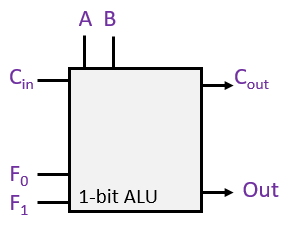In this post we will create an Arithmetic & Logic Unit (ALU) using logic gates. The ALU is one of the main component of the CPU. It is used in the Execution stage of the FDE cycle to perform all the logical (e.g. AND, OR, NOT) operations and all the arithmetic calculations (e.g. ADD, SUB instructions).
Our ALU will perform 4 different operations: three logical operations (NOT, OR and AND) and one arithmetical operation (ADD: +). Here is the instruction table for our ALU:

The ALU will have a built-in 2-to-4 binary decoder that can decode 2-bit instructions represented by inputs F0F1.
The Logic unit of our ALU will apply a NOT mask to input A or an OR and an AND masks to inputs A and B.
The Arithmetic unit will use a full adder to perform an addition of A and B (including carried values) and output the binary sum and the carry out value.
1-bit Arithmetic & Logic Unit
Here is the logic gates diagram for out 1-bit ALU:

8-bit Arithmetic & Logic Unit
Let’s represent our 1-bit ALU with the following diagram:

By connecting eight 1-bit ALU together, we obtain an 8-bit ALU:
Note that a single decoder can be used to control all the 1-bit ALUs. There is no need to replicate this decoder eight times.
The last carried value can be used to detect overflows when performing a binary addition on the two Bytes of data A and B.

